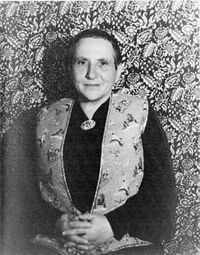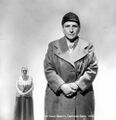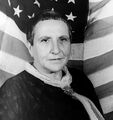Gertrude Stein: Difference between revisions
No edit summary |
No edit summary |
||
| Line 2: | Line 2: | ||
[[Category:Songs used in pre-show]] | [[Category:Songs used in pre-show]] | ||
[[Category:Concert Backdrop]] | [[Category:Concert Backdrop]] | ||
[[File:Gertrude-stein.jpg | 200px | right | thumb |Gertrude Stein]] | |||
==Relevance== | ==Relevance== | ||
Her poem about Matisse (read by herself) was used as a pre-show track. | Her poem about Matisse (read by herself) was used as a pre-show track. | ||
Latest revision as of 14:48, 16 April 2023
Relevance
Her poem about Matisse (read by herself) was used as a pre-show track. Her image by Sir Cecil Beaton was used as part of the 2022 stage backdrops.
Image used as a backdrop in 2016 (during "All The Lazy Dykes"):
Mentioned In
- World Tour 2011 Pre-show Tracks
- Morrissey: "The last thing security forces ever want is peaceful protest" - Vegan Logic (September 5, 2014)
Wikipedia Information
 |
Gertrude Stein (February 3, 1874 – July 27, 1946) was an American novelist, poet, playwright, and art collector. Born in Allegheny, Pennsylvania (now part of Pittsburgh), and raised in Oakland, California, Stein moved to Paris in 1903, and made France her home for the remainder of her life. She hosted a Paris salon, where the leading figures of modernism in literature and art, such as Pablo Picasso, Ernest Hemingway, F. Scott Fitzgerald, Sinclair Lewis, Ezra Pound, Sherwood Anderson and Henri Matisse, would meet. In 1933, Stein published a quasi-memoir of her Paris years, The Autobiography of Alice B. Toklas, written in the voice of Alice B. Toklas, her life partner. The book became a literary bestseller and vaulted Stein from the relative obscurity of the cult-literature scene into the limelight of mainstream attention. Two quotes from her works have become widely known: "Rose is a rose is a rose is a rose", and "there is no there there", with the latter often taken to be a reference to her childhood home of Oakland. Her books include Q.E.D. (1903), about a lesbian romantic affair involving several of Stein's friends; Fernhurst, a fictional story about a love triangle; Three Lives (1905–06); The Making of Americans (1902–1911); and Tender Buttons (1914). Her activities during World War II have been the subject of analysis and commentary. As a Jew living in Nazi-occupied France, Stein may have only been able to sustain her lifestyle as an art collector, and indeed to ensure her physical safety, through the protection of the powerful Vichy government official and Nazi collaborator Bernard Faÿ. After the war ended, Stein expressed admiration for another Nazi collaborator, Vichy leader Marshal Pétain.



